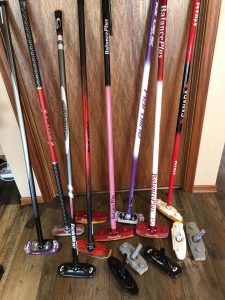No self-respecting golfer would simply walk into a golf pro shop or retail outlet to buy a new set of clubs without going through the process of getting fitted. Fitting is an assessment process that involves the analysis of a golfer’s swing and physiology to ensure that the golf clubs under consideration “fit” the player, enabling the player to strike the ball square in the middle of the club face with a shaft whose flex matches the player’s swing speed, among other trade-offs. A summary of factors involved in golf club fitting can be found in this article entitled “Clubfitting 101” by MyGolfSpy. While the MyGolfSpy article covers the details of club head variations that can suit different types of players and their style of game, the article also covers consideration of the choice of club shafts, particularly:
- shaft flex. Simplistically, higher swing speeds warrant stiffer club shafts though this is an overgeneralization. Other factors include release pattern and shaft deflection.
- shaft weight. Heavier shafts tend to produce lower-loft golf shots.
- shaft material. Today shafts are available in steel (of different flex), carbon fibre (of different characteristics) and of composite design which combine the two.
- shaft length. Taller individuals may benefit from clubs that are slightly longer, and vice-versa.
- adjustability. Today’s golf clubs can often be “tweaked” to customize a specific club for a particular swing.
If you think about it, today’s sporting goods manufacturers provide considerable choice to suit a diverse population in many sports. In addition to golf clubs, hockey sticks, tennis and squash racquets, baseball bats and gloves, and running shoes are just a few examples of goods that offer significant choice so that the equipment can best suit a particular individual when playing a sport.
What about curling?
Experimentation and innovation has been a hallmark of curling brush manufacturers since players converted to brushes from corn brooms in the mid-1980s. Today, manufacturers such as Goldline, Hardline, Asham, Balance Plus, Performance, and Olson continue to offer different brush designs to differentiate their products to improve grip and lower the weight of a brush to reduce player fatigue.
Are all curling brushes the same? Today, virtually all curling brush handles are 48 inches in length (recent Balance Plus handles are now 47 inches). That wasn’t the case in the 1980’s when manufacturers experimented with different designs, including placing an “S” in the middle of the handle as a hand rest. So today, in terms of handle length, there is basically no variability. However, brush models from the various manufacturers are different. In an earlier post, I documented the variance in brush pad size and weight. And our research project with brush pads indicates that various brushes distribute pressure across the pad in very different ways.
For a brush handle, athletic factors that may influence the choice of brush handle include:
- grip position on the handle;
- body weight and height of the athlete;
- size of the athlete’s hands;
- whether the athlete used gloves, mitts, or bare hands when brushing;
- the athlete’s stance (open or closed) and body position when brushing; and
- grip strength, particularly with the lower hand.

When I work with a team in a brushing practice I usually bring a large broom bag full of various brushes and models for the athletes to try, even if they are already committed to a particular manufacturer, usually because of sponsorship commitments. I do that because it’s one of the few opportunities athletes – particularly younger athletes – may have to compare brushes side-by-side, on the ice, in the same practice. What is interesting is how frequently the athletes I work with fall in love with a brush that is different from the one they’re using. There are several reasons for that. Occasionally it will be because of the “feel” of the brush pad on the ice surface, or because a brush uses “sleeves” instead of “pads”. But much more often, the choice of brush is actually based on the characteristics of the brush handle.
In Part Deux of this article, I’ll document some brush handle characteristics from the various manufacturers to present a sense of the differences amongst the various models.